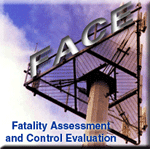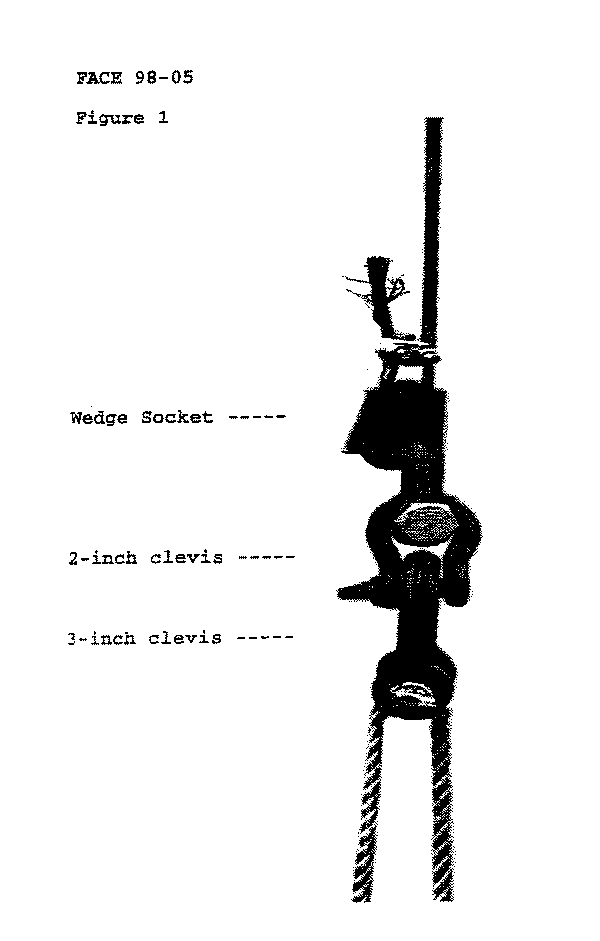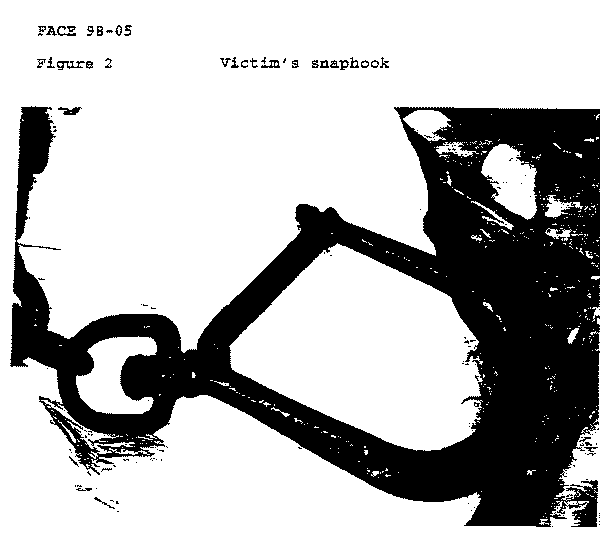NIOSH Fatality Assessment and Control Evaluation (FACE) Program
|
Tower Worker Dies After Falling 130 Feet From Hoist
Cable To Ground in Pennsylvania
|
| NIOSH In-House FACE Report |
FACE 9805
|
SUMMARY (top)
A 32-year-old male tower erector (the victim) died after falling 130 feet to the ground from a hoist cable he was riding. The victim was a member of a seven-man crew that had completed the erection of a 160-foot-high cellular telephone tower. The crew was in the process of lowering the gin pole (device used to lift the tower sections into place) to the ground when the incident occurred. The victim had removed two choker cables securing the upper portion of the gin pole to the tower and was attempting to ride the hoist cable down to the two lower chokers when the  hook on his lanyard slipped off the cable and the victim fell to the ground. Co-workers summoned the rescue squad from a nearby rehabilitation center. The victim was pronounced dead at the scene by the county coroner. NIOSH investigators concluded that, to prevent similar incidents, employers should: hook on his lanyard slipped off the cable and the victim fell to the ground. Co-workers summoned the rescue squad from a nearby rehabilitation center. The victim was pronounced dead at the scene by the county coroner. NIOSH investigators concluded that, to prevent similar incidents, employers should:
-
instruct workers not to use the hoist line for access and egress during tower construction and to maintain 100% fall protection while on towers
-
provide workers with proper personal protective equipment, ensure its use, ensure that it is properly maintained, and instruct workers in the proper methods of tying off
-
continually stress to all employees the importance of following established safety rules and procedures at all times
-
ensure that equipment is used in accordance with manufacturer's specifications
-
ensure that equipment is properly installed prior to the start of work.
INTRODUCTION (top)
On December 8, 1997, a 32-year-old tower erector (the victim) died after falling 130 feet to the ground from a hoist cable he was riding. On December 9, 1997, personnel from the Division of Safety Research (DSR) contacted the area office of the Pennsylvania Occupational Safety and Health Administration (PAOSHA), and offered technical assistance. On December 12, 1997, a DSR safety specialist and a research industrial hygienist from the Education and Information Division (EID) met with the two PAOSHA compliance officers assigned to the case to review the case, then traveled to the incident site with the compliance officers to conduct an investigation. A videotape of the site taken immediately after the incident was viewed at the OSHA office and the safety equipment worn by the victim was photographed. The site was videotaped and photographed.
The employer was a multi-state firm that employed 2,700 workers and specialized in the erection of radio and telecommunication towers. Prior to the NIOSH investigation of this incident, the workers had returned to their base company branch in Tennessee, leaving their equipment. The PAOSHA compliance officers were able to conduct opening interviews with the workers before they returned to their base. This branch of the company had been in operation for 1 year. The company did furnish PAOSHA with a copy of their company safety and training manual. The written manual detailed a comprehensive safety and training program; however, evidence at the scene suggested that the safety program was not strictly enforced.
INVESTIGATION (top)
The employer had been contracted by a telecommunications company to erect a 160-foot high cellular telephone tower. The seven-man crew (3 tower men, 3 groundmen, and a supervisor) had been at the scene for 3 days and had completed the erection of the tower. The first 100 feet of the tower were erected using a crane to lift the tower sections into place. A gin pole (a lifting device used to lift the tower sections into place) was attached to the tower to lift the final sections. To complete the job, the men had only to lower the gin pole from the top of the tower to the ground using a hydraulic hoist located approximately 150 feet from the tower. Temperatures were freezing and the muddy ground at the site was frozen on the surface.
At the time of the incident, the victim had been hoisted alone on the cable (d-inch wire rope) to a height of 130 feet to remove two wire-rope chokers that secured the upper portion of the gin pole to the tower. The victim had hooked the snaphook at the end of his lanyard to a clevis connected to the hoist line's terminal device in order to be lifted by the hoist line. After the victim had removed the chokers, he signaled the hoist operator to lower him to the bottom chokers 30 feet below. Co-workers stated that as the victim stepped away from the tower, he attempted to re-attach the snaphook from his lanyard to the hoist cable. The snaphook slipped off the hoist line and the victim fell 130 feet to the ground.
A co-worker ran to a nearby rehabilitation center to summon the emergency medical service. Cardiopulmonary resuscitation was not initiated due to the extent of the victim's injuries. EMS personnel arrived and contacted the county coroner, who pronounced the victim dead at the scene.
Investigation revealed that a wedge socket was attached to the end of the hoist line. Immediately attached to the wedge socket was a 2-inch clevis. A 3-inch clevis was attached to and below the 2-inch clevis (Figure 1). The large clevis measured an 1:-inches thick by 4-inches wide at its largest. The inside dimensions of the snaphook on the victim's lanyard were 43-inches wide by 73 -inches long at its largest (Figure 2). If the victim had tried to attach his snaphook to the hoist line, it would have slipped over the large clevis allowing the victim to fall to the ground. It is also possible that the victim reached to connect the snap hook to the clevis but either missed the clevis or did not make a good connection. Additionally, one of the cradle legs on the victim's snaphook was bent open, jeopardizing the integrity of any attachment the victim would have attempted to make.
During interviews with the PAOSHA compliance officers, the two workers that worked on the tower with the victim stated that all three men rode the "headache ball" at the end of the hoist line up the tower at the same time. One man would hook to the clevis, while the other two would hook to the "headache ball," which in this case was a 30-inch almost-square device fashioned out of 2-inch- square mechanical tubing. At the time of the incident, the headache ball was not attached to the hoist line; the line terminated at the wedge socket.
CAUSE OF DEATH (top)
The county coroner listed the cause of death as multiple internal traumatic injuries.
RECOMMENDATIONS/DISCUSSION (top)
Recommendation #1: Employers should instruct workers not to use the hoist line for access and egress during tower construction and to maintain 100% fall protection while on towers.
Discussion: In this case, the employee fell from the tower after he apparently was attempting to connect his fall protection in order to be lowered by the hoist line. Employers should instruct tower workers to maintain 100% fall protection during tower construction. 100% fall protection is defined as follows: every employee at risk of fall from work levels over 6 feet above the ground or working surface must be protected by some conventional means of fall protection, which may include an integral fall arrest system. This applies to ascending, descending, moving point to point, or any tower construction or alteration work activity conducted at an elevated work station. Employers should also require a minimum of three-point contact (two hands, one foot or two feet, one hand) at all times.
Traditional fall protection for this job is more effective when the employee is stationary and tied onto the structure. It is recommended that other methods of fall protection be used that protect employees while they are moving as well as when stationary. Employees should be equipped with two lanyards so that while moving from point to point, one lanyard will be connected to the tower at all times. Additionally, a lifeline system or cable safety climb device attached to the highest point of the tower leg provides a tie-off point for the employee to hook onto, and provides fall protection coverage at all times. For a tower leg or similar vertical structure, a fall arrester (e.g., rope grab) should be worn by the employee and attached to the lifeline, enabling the worker to move freely without interference until a free fall is detected. In this case, a lifeline was attached to the highest point of a tower leg and was equipped with a rope grab and a carabinier device for lanyard attachment; however it was not utilized by the workers. If these types of fall protection are not feasible, safety nets should be installed at the worksite in accordance with 29 CFR 1926.105(a)which states that safety nets shall be provided when workplaces are more than 25 feet above the ground where the use of ladders, scaffolds, catch platforms, temporary floors, safety lines, or safety belts is impractical.
Recommendation #2: Employers should provide workers with proper personal protective equipment (PPE), ensure it use, ensure that it is properly maintained, and instruct workers in the proper methods of tying off.
Discussion: In this instance, the victim either hooked directly to the hoist cable and the large hook slipped over the smaller components of the cable's terminal device or attempted to hook to the clevis and failed. 29 CFR 1926.502 (d)(5) states that snaphooks shall be sized to be compatible with the member to which they are connected to prevent unintentional disengagement, or shall be a locking type snaphook designed and used to prevent disengagement. 29 CFR 1926.502 (d)(6)(i) states that unless the snaphook is a locking type, it shall not be engaged directly to webbing, rope, or wire rope. The snaphook in this instance was not a locking type and was not compatibly sized to the components of the cable's terminal device. A smaller locking snaphook or a connection to one of the clevises may have prevented this fatality. Additionally, one of the cradle legs on the snaphook was bent open, increasing the possibility of a cable rollout. It is possible that this damage occurred during the incident; however, PPE should be inspected on a daily basis to ensure that it is in proper working condition. When contacted, the manufacturer of the hook stated that the hook was not intended to lift personnel. Beginning January 1, 1998, locking snaphooks are required.
Recommendation #3: Employers should continually stress to all employees the importance of following established safety rules and procedures at all times.
Discussion: Standard company procedure calls for testing the connection of the anchorage point prior to releasing a grip on the structure. The company also had a policy of three-point contact at all times if not tied-off. It appears that the victim did not test his connection prior to relying on it to support his full weight or lost one of his three points of contact with the structure. In accordance with the OSHA Act, P.L. 91-596, Section 5(b)."each employee shall comply with occupational safety and health standards and all rules, regulations, and orders... which are applicable to his own actions and conduct." The employer in this incident did have a comprehensive and detailed safety program on the project that addressed the hazards to which the employees could reasonably expect to be exposed. The fact the incident occurred in spite of these policies clearly shows the need for employers to continually remind all employees of the importance of following established safety rules and procedures at all times. Employees should be trained in the proper safest work procedures to perform their tasks. If retraining is necessary, it should be conducted at the necessary intervals.
Recommendation #4: Employers should ensure that equipment is used in accordance with manufacturer's specifications.
Discussion: The hoist used in this incident was not rated for the transport of personnel, and warning labels on the hoist stated that the winches were not intended for use in the lifting or moving of persons. Equipment should only be used as rated by the manufacturer in accordance with 29 CFR 1926.553 (a)(4) which states, all base-mounted drum hoists in use shall meet the applicable requirements for design, construction, installation, testing, inspection, maintenance, and operations, as prescribed by the manufacturer.
Recommendation #5: Employers should ensure that equipment is properly installed prior to the start of work.
Discussion: The hoist used in this incident was not anchored to prevent it from being pulled forward, or twisted or turned. The hoist should be anchored so as to resist at least two times the reaction induced at the maximum attainable line pull and should be anchored so that the hoist can not be twisted or turned. Tracks in the mud were evidence that the hoist had moved left and right and forward during use.
REFERENCES (top)
1. Public Law 91-596, December 29,1970, the "Occupational Safety and Health Act of 1970", Section 5(b).
2. Code of Federal Regulations 29 CFR 1926, 1996 edition. U.S. Government Printing Office, Office of the Federal Register, Washington DC.


3-inch clevis was attached to and below the 2-inch clevis
|